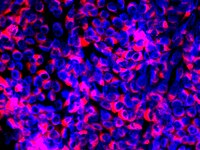
Photo from wikipedia
Abstract AIMS: To evaluate a vaccine containing type 1c bovine viral diarrhoea (BVD) virus for prevention of fetal infection in pregnant heifers when challenged with New Zealand BVD virus type… Click to show full abstract
Abstract AIMS: To evaluate a vaccine containing type 1c bovine viral diarrhoea (BVD) virus for prevention of fetal infection in pregnant heifers when challenged with New Zealand BVD virus type 1a 6 months after vaccination, compared to unvaccinated heifers and heifers vaccinated with a vaccine containing type 1a BVD virus. METHODS: Fifty five crossbred Friesian heifers, free from BVD virus and antibody, were randomly allocated to three groups. Twenty five heifers were vaccinated twice with a vaccine containing type 1c BVD virus (T1c group), and 10 heifers with a vaccine containing type 1a BVD virus (T1a group), and 20 heifers were unvaccinated (NC group). After oestrus synchronisation the heifers were bred by artificial insemination followed by natural bull mating. Six months after booster vaccination 15 heifers from the T1c group, eight from the T1a group, and 15 from the NC group, were exposed to four calves that were persistently infected with type 1a BVD virus, for 4 weeks. At the beginning of the challenge phase 36/38 heifers were 72–74 days pregnant and 2/38 heifers were approximately 53 days pregnant. Approximately 52 days after the start of the challenge the heifers were subjected to euthanasia and fetal tissues were collected for the detection of BVD virus by ELISA in fetal heart blood and PCR in fetal tissues. RESULTS: Based on PCR results, BVD virus was detected in 15/15 fetuses in the NC group, compared to 4/14 fetuses in the T1c group and 3/8 fetuses in the T1a group. The proportion of BVD virus-positive fetuses was lower in both vaccinated groups compared to the NC group (p<0.002), but there was no difference in proportions between the vaccinated groups (p=1.00). Fetal protection, expressed as the prevented fraction, was 71.4 (95% CI=41.9–91.6)% and 62.5 (95% CI=24.5–91.5)% for the T1c and T1a groups, respectively. CONCLUSIONS AND CLINICAL RELEVANCE: The vaccines containing killed type 1c and type 1a BVD viruses significantly reduced fetal infection following challenge with a New Zealand type 1a BVD virus. Prevention of fetal infection by vaccination may not be 100%, and the risk of persistently infected calves being born to some vaccinated cattle should be acknowledged and managed as part of a BVD control programme.
Journal Title: New Zealand Veterinary Journal
Year Published: 2017
Link to full text (if available)
Share on Social Media: Sign Up to like & get
recommendations!